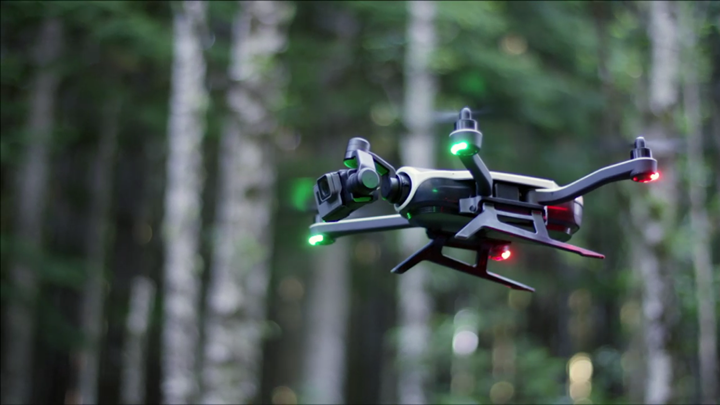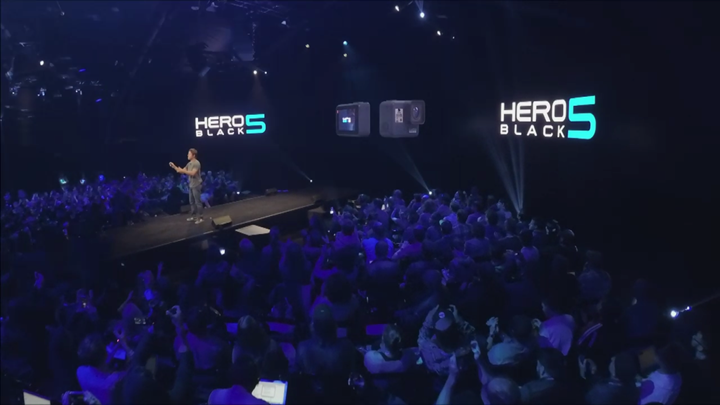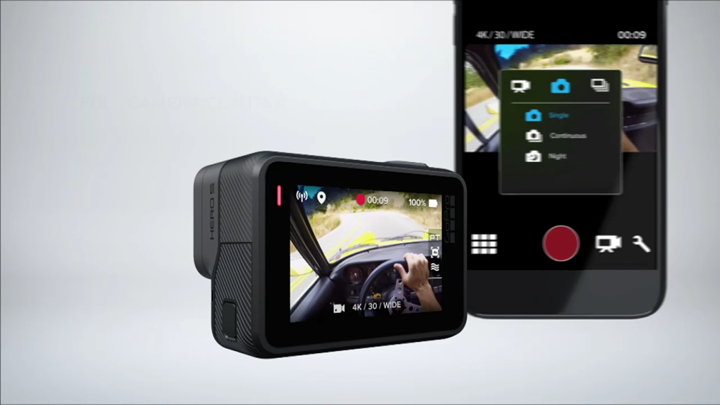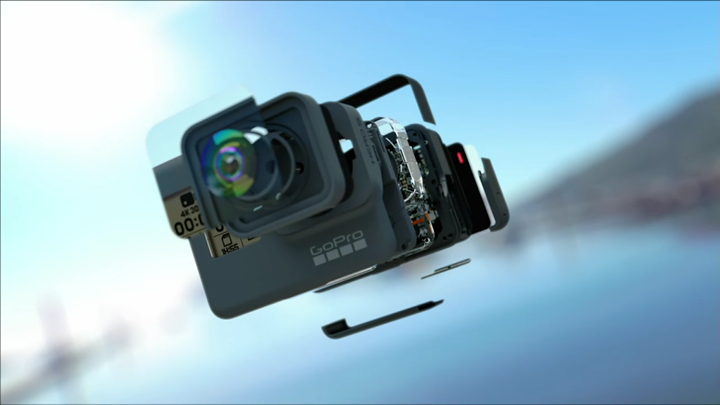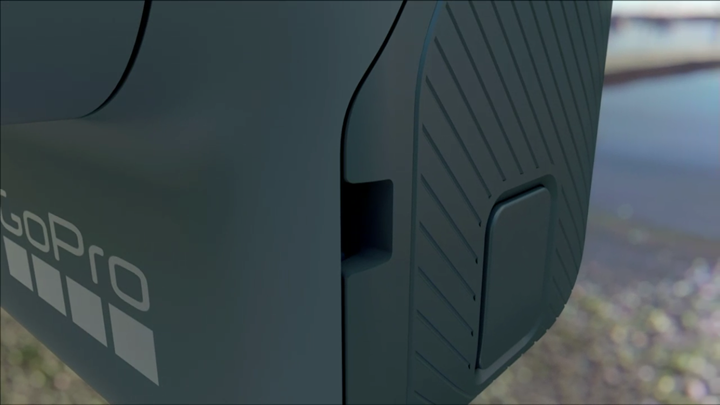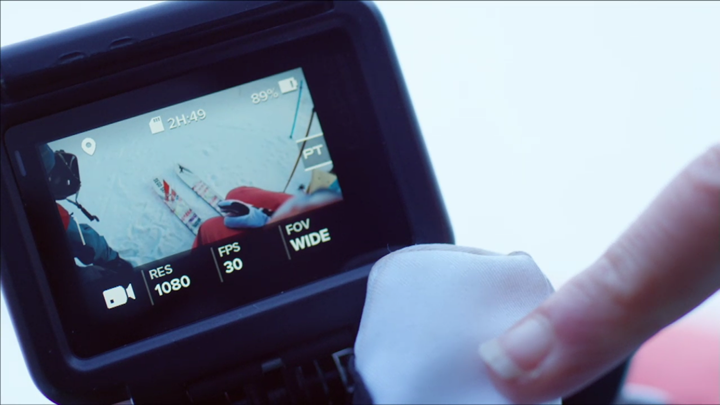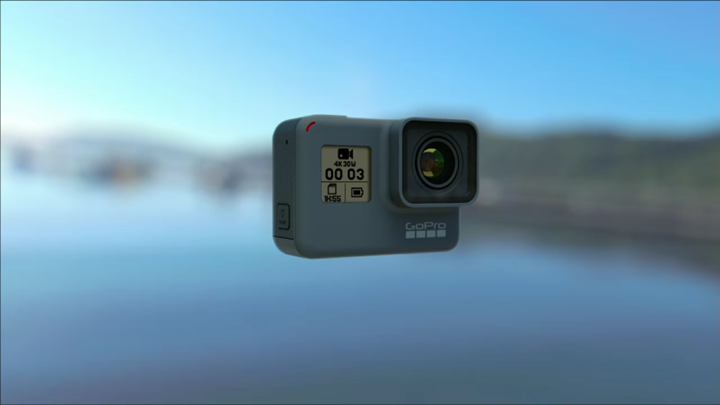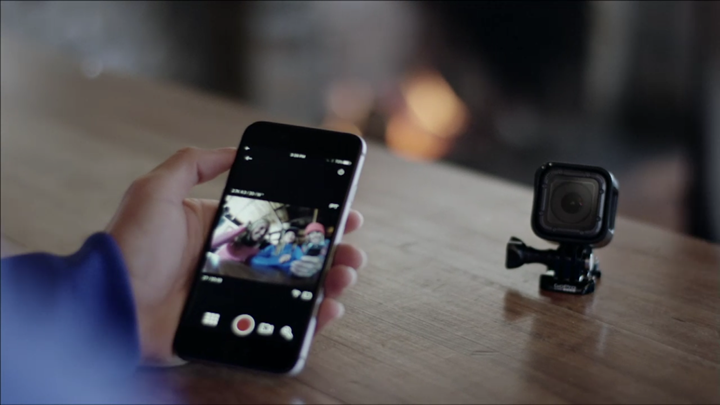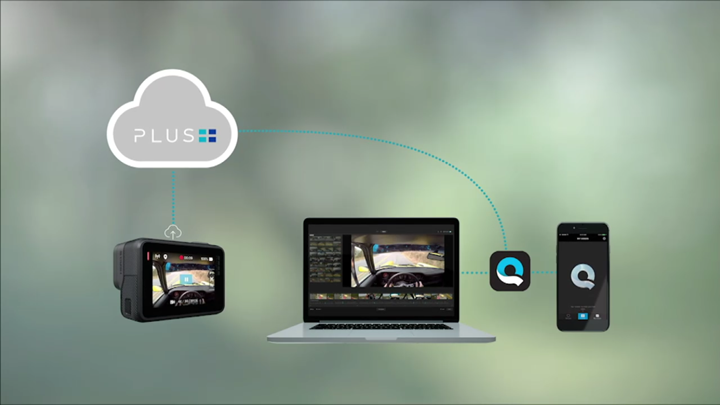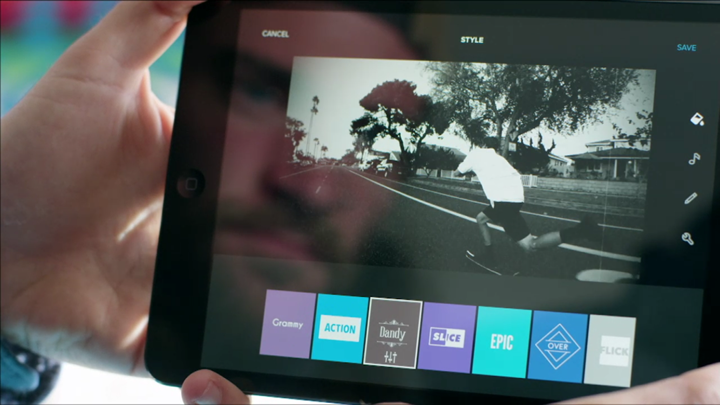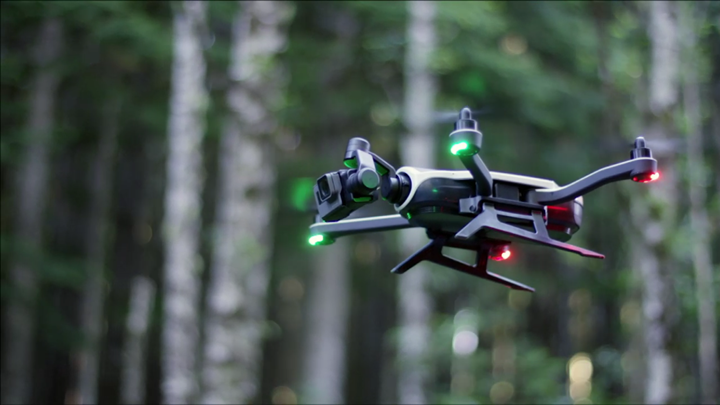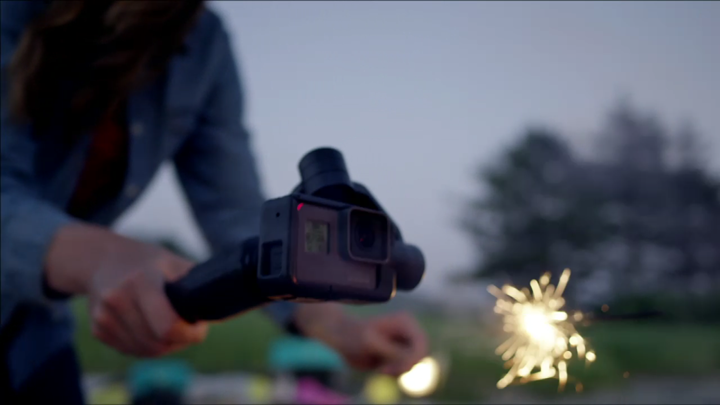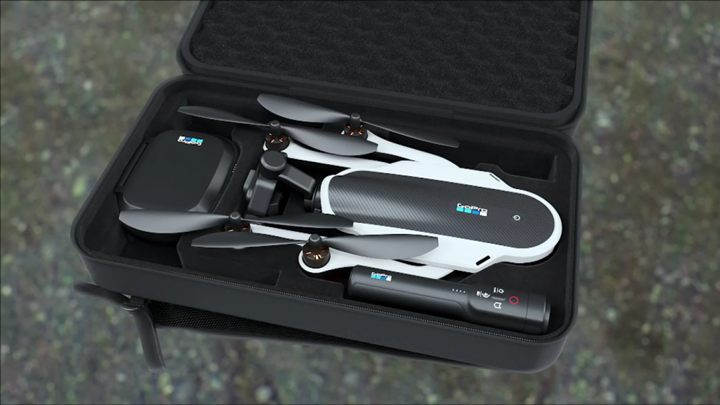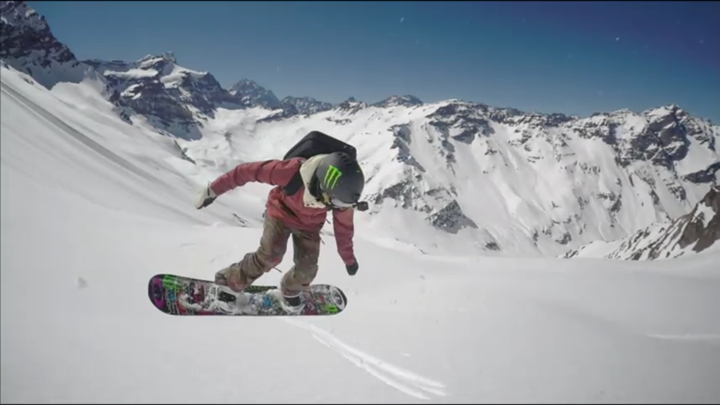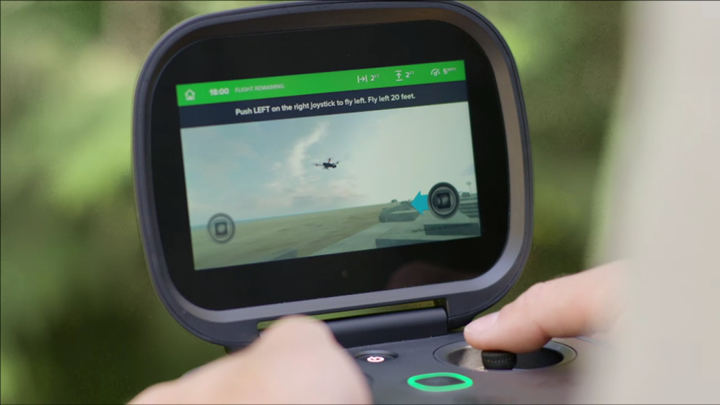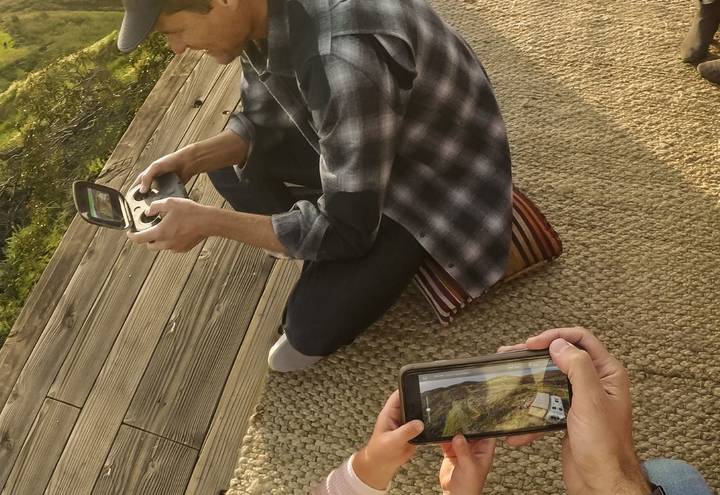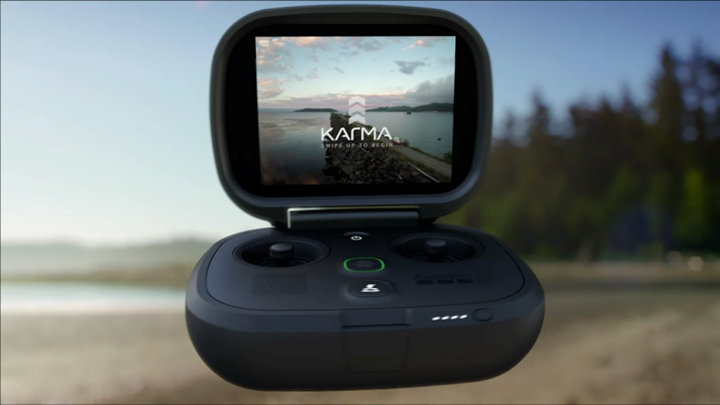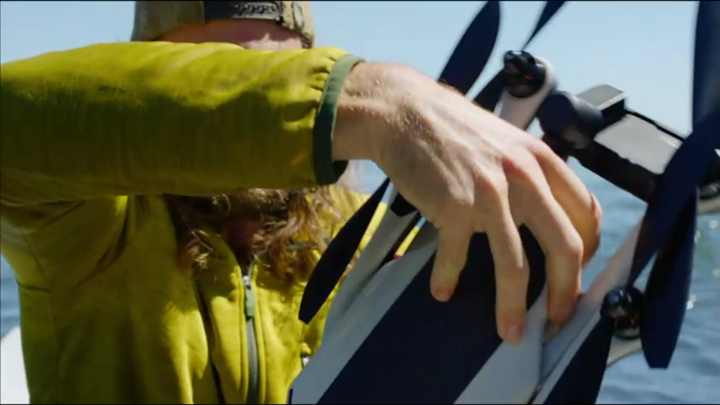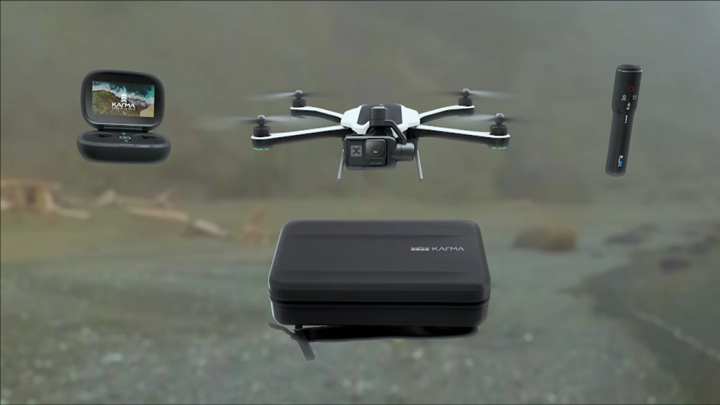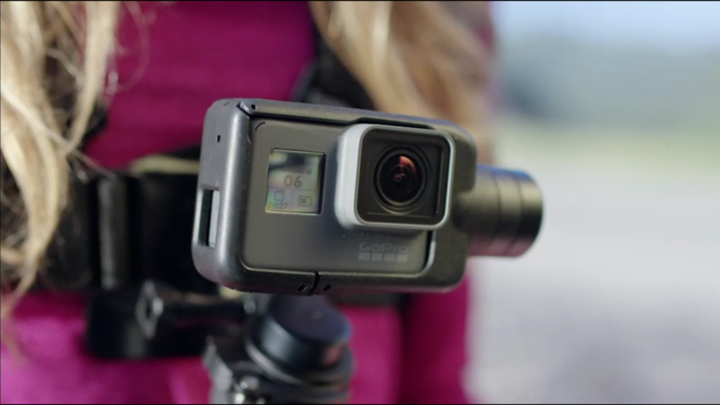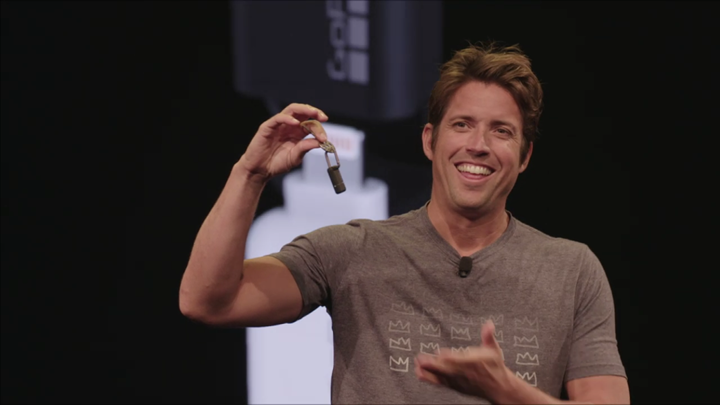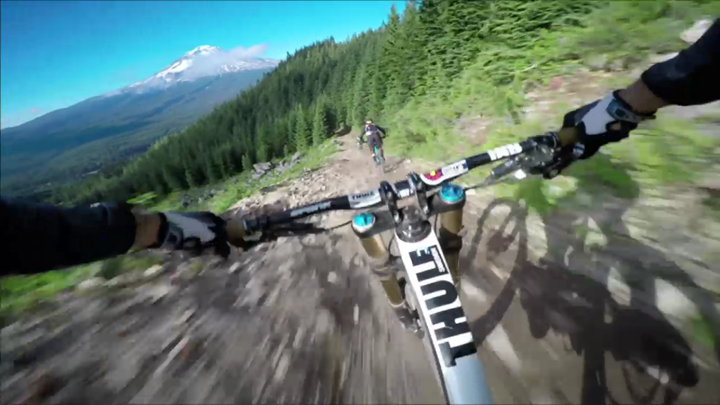Today GoPro announced three new action cameras, a drone, and a rather interesting flotilla of accessories. These include a handheld gimbal, external microphone/remote combos, and even a nifty $19 adapter to quickly sync your videos to your phone sans-battery.
Now, I’ll be putting together a more hands-on piece over the next 24-48 hours, but until then, consider this a bit of an appetizer and landing place to discuss the new units. Obviously there’s quite a bit of interest given it’s been two years since a major GoPro camera lineup launch (or, over a year if you count the Session).
Let’s dive straight into things!
The New Hero5 cameras:
Now technically, there are two new Hero5 branded cameras and one new non-Hero5 branded, but that’d have made for too long of a section header. So what has GoPro done? Well, they’ve simplified. Over the past two years they had amassed a wide number of camera price points that confused the market. Back in April they reduced that count a bit, but now they’ve cut everything down to these three new models:
1) GoPro Hero5 Black: $399 – Their top-end camera, complete with GPS and 4K, voice control and image stabilization
2) GoPro Hero5 Session: $299 – The square Session body with high-end 4K specs, voice control, and image stabilization
3) GoPro Hero Session: $199 – Same square Session from before, but with a minor microphone update
This means that the entire lineup has received a refresh, and it’s also down to just three camera models (from six). Note that down below I have a comparison table comparing the features of the higher-end Hero5 Black to that of Garmin’s VIRB Ultra 30 offering, but for this section I’ll highlight the key new features.
GoPro Hero5 Black:
The Hero5 Black is in many ways the features and specs of a Hero4 Silver & Black merging together. It’s got the resolution/quality specs of a Hero4 Black (4K video @ 30FPS), but it’s got the touchscreen like a Hero4 Silver did. However, that touch screen menu system has been greatly simplified, making it easier for folks to figure out what they’re doing:
As you probably noticed above, the touchscreen is on the exterior of the camera case – and that’s because the cameras are now fully waterproofed – no external case required. The entire GoPro lineup of cameras is now waterproof to various levels, with the Hero5 Black being waterproof to 10 meters (33ft).
The Hero5 Black does see improvements in video and audio though. For example, on the audio front they’ve introduced three microphones, including noise cancelling. This puts it more inline with the VIRB Ultra 30 in terms of minimizing wind noise. On the Hero5 Black, these mics are located on the sides and top of the camera, and the unit will automatically choose the best sounding microphone during recording.
Next, both the Hero5 Black and Hero5 Session include voice control, fairly similar to what Garmin introduced with their VIRB Ultra 30 cameras a few weeks ago. However, GoPro both allows you to customize these commands and has more commands than the VIRB Ultra 30.
Next, GoPro added the ability to record GPS data. Some of this is a bit unclear as to how exactly the GPS data will be used (for example, can you overlay speed during a recording?). Right now it just says it records position. But I’m sure those answers will become clear soon. This feature puts it back in the camp of the vast majority of action cams these days that have GPS within them.
However, GoPro has set itself apart by introducing the ability to record RAW images (photos) – which is pretty cool. They also introduced a new HDR mode (which they call WDR). It allows you to get more dynamic shots for photos.
Finally, the Hero5 Black and Hero5 Session both got image stabilization. It’s electronic image stabilization, which like the new Garmin action cam means it’s done within software rather than through hardware. So basically it takes the 4K image and uses a portion of that to give you a smooth 1080p image. Thus, the highest EIS (Electronic Image Stabilization) mode is 1080p.
Ok, so how does this new top-dog camera compare to the just released Garmin VIRB Ultra 30? Well, this handy-dandy chart I’ve put together should help you a bit:
GoPro Hero5 Black vs Garmin VIRB Ultra 30
| Feature Listing | GoPro Hero5 Black | Garmin VIRB Ultra 30 | Feature Winner |
|---|---|---|---|
| General: Price | $399 | $399 | – |
| General: Touchscreen control | Yes | Yes | – |
| General: Waterproof | Internally to 10m | With case to 30m | GoPro (but depends on preference) |
| General: Battery life | Undeclared @ 1080p30 | 2hr 15min @ 1080p30 | TBD |
| General: WiFi & Bluetooth | Yes | Yes | – |
| Data: GPS Enabled | Yes | Yes | – |
| Data: Accelerometer/Gyro/Altimeter/Compass | No | Yes | Garmin |
| Data: Can connect to sport/automotive/boat sesnors | No | Yes | Garmin |
| General: USB Connector Type | Type-C | Mini-USB | Depends on preference |
| General: Voice Control | Yes | Yes | GoPro (can customize) |
| Video: Highest resolution | 4K @ 30fps | 4K @ 30fps | – |
| Video: Highest frame rate | 720p @ 240fps | 720p @ 240fps | – |
| Video: Electronic Image Stabilization | Yes up to 1080p | Yes up to 1440p | Garmin |
| Video: Remove distoration mode | Yes | Yes | – |
| Video: Wind cancellation | Yes | Yes | – |
| Photo: Highest resolution | 12MP | 12MP | – |
| Photo: Highest burst mode | 30 frames/sec | 60 frames/sec | Garmin |
| Photo: Ability to have pro settings mode | Yes | Yes | – |
| Photo: Ability to shoot RAW files | Yes | No | GoPro |
| Photo: HDR photo option | Yes | Yes | – |
| Accessories: Uses GoPro mount | Yes | Yes | – |
| Accessories: Gimbal option | Yes | Not really | GoPro |
| Accessories: Drone connection option | Yes | Sorta but not ideal | GoPro |
| Accessories: External auto-sync mic/remote | Yes | No | GoPro |
| Software: Mobile app | Yes | Yes | GoPro faster, Garmin more options |
| Software: Desktop Apps | Yes | Yes | Garmin for more powerful editing |
| Software: Can automatically create highlight movies | Yes | Yes | GoPro’s mobile better, Garmin’s Desktop |
I’ll work to add in the Hero5 Black to the larger product comparison database, as well as the Hero5 Session.
GoPro Hero5 Session:
Next they introduced an updated version of the Hero4 Session, called the Hero5 Session. You’ll remember this is the cube-like camera that was introduced last year. This time they’ve spun out two variants:
Hero5 Session: Many of the specs of a Hero5 Black, but in a tiny form factor – $299
Hero Session: Basically the old session, but with improved mics – $199
CEO Nick Woodman noted that the Session is “meant to be dropped” and that it’s “incredibly difficult to kill a Session”. Which is true, they’re a beastly little waterproof cube. I can attest to my attempts to kill one.
So what do you miss by going with a Hero5 Session over the Hero5 Black? Here’s what’s missing from a major feature standpoint:
– No Touchscreen (have to use phone for preview/etc…)
– 1080p @ 90FPS instead of 120FPS
– 10MP instead of 12MP photos
– No RAW photo support
– No GPS
So for many people, the Hero5 Session will be perfect. Yet for others (like me), I like the touchscreen on the back of the camera for quick validation of framing and playback. It’s something I’ve come to love on the GoPro Hero4 Silver and the Garmin VIRB Ultra 30.
GoPro Plus Cloud Platform:
GoPro announced their new cloud platform called GoPro Plus. This platform will allow you to sync your content to their cloud platform as soon as it starts charging (via WiFi) with a Hero5 Black or Hero5 Session. Which in turn enables you to edit it from the cloud. For the Hero4 and older cameras, you’d link to your computer first to upload to GoPro Plus.
The GoPro Plus account will set you back $4.99/month, though you can use a free trial version initially. Now what’s interesting here is that the subscription also gets you 20% off any mounts or accessories. That’s pretty solid, considering GoPro’s mounts are often pretty pricey.
Within the platform is the ability to automatically create videos from snippets and have them at preset lengths (i.e. for Instagram) and then have music auto-synced to the video. I’ll likely do a bit of a deeper dive into this in the near future.
Of note is that GoPro has tweaked the pricing on their ‘GoPro Care’ warranty option, which covers you in case you kill your camera. They’ve also extended it to cover the Karma drone. The new pricing is:
$59 for Hero5 Session
$79 for Hero5 Black
$159 for Karma drone (w/o camera)
$179 for Karma drone (with camera)
To me these prices are fair, and a nice dip from the previous $99 for the Hero4 Black price as well. I’ve got no doubt I’ll pickup the GoPro Care package on the drone, though will probably skip it for the camera (given it’ll be far more difficult to kill than the drone will).
Karma Drone:
Finally, just finally. The long-touted Karma drone has arrived. But, as hinted at lately it was more than just a drone – but rather a platform for components including a handheld gimbal.
The Karma Drone shares many design elements previously seen in the Airdog drone, which is aimed at sports action. For example, Karma folds up into a backpack (like how I’ve showed for Airdog in this video), even with the props on – which is pretty handy.
In fact, GoPro is including the backpack in their kit price, along with the gimbal. The backpack will hold the Karma drone, the controller, and the gimbal, as seen above.
Having skied, cycled, and hiked quite a bit with drones – this backpack definitely looks a bit cleaner than what I use today.
The unit is compatible with the majority of their recent higher-end cameras:
Hero4 Session
Hero4 Silver
Hero4 Black
GoPro Session
Hero5 Session
Hero5 Black
The Karma drone is controlled by this fold-up remote. The remote has a 720p live preview screen on it, as well as simplified modes for control – similar to what we’ve seen from 3DR, Hexo and DJI (among others).
An interesting differentiation point is the ability to pair a phone to the controller and have a friend both view the cameras footage, but also control the camera. This is similar to what DJI does with their secondary operator remote concept. But GoPro is now offering it at the base units, and without any additional hardware. The idea here being to have one person focus on flying the aircraft, while another nails the shot. This also complies with some regulations around camera drone use in commercial work.
One area that’s missing though is automatic control/follow of a subject – which is quite a bit of a gap compared to DJI, 3DR, Yuneec, and Airdog. Nor does it have any object avoidance. In GoPro’s investor call they noted that they didn’t see other companies at the level of accuracy that they wanted.
Like others though, it includes common features such as automatic return to home (and a button for it), as well as one-button take-off and landing. And upon setup completion, the controller will also walk you through a flight simulator mode to practice your aerial prowess.
Next, the unit has a 3-axis stabilizing gimbal, on-par in spec to what we’ve seen by other companies in the space. However, what’ll be most important to watch for is the exact stability of it. There are varying degrees of quality when it comes to gimbals, and those quality differences are exaggerated in drones. So folks will have to wait a bit to see what footage looks like when it’s not first edited by GoPro’s team of editors.
Note that the company shifted the camera up-front, to ensure it’s out of view of the props in the majority of situations. It also makes it easier to fit in a backpack.
When it comes to battery life, the Karma drone is getting 20 minutes (the controller is 4 hours), which is on the low-end for consumer drones these days. DJI’s latest units can get closer to 30 minutes, though the Airdog is down around 15 minutes. On the bright side, the charging time for the battery is only an hour, and you could carry extra batteries. Each battery is 19.3oz in weight. The drone in total is 35.5oz.
From a specs standpoint, here’s some notable ones:
Maximum Speed: 35 mph (15 m/s)
Maximum Distance: 3,280ft (1000m)
Maximum Flight Altitude: 14,500ft (4,500m)
Maximum Wind Resistance: 22mph (10m/s)
The pricing is incredibly appealing. Here’s what it’ll set you back once it ships on October 23rd:
$799: Drone, gimbal, and backpack (no camera)
$999: Base kit plus the Hero5 Session camera (saves $100)
$1099: Base kit plus the Hero5 Black camera (saves $100)
At these prices, it’ll definitely take a bite out of DJI’s market, especially in the mid to upper range models (i.e. DJI Phantom 4). The GoPro brand will sell far better to the average consumer than the relatively unknown DJI brand (again, to the average person walking into a Best Buy). Of course, to the higher end consumer and those who are more aware of the drone landscape, DJI will likely dominate with its continued expansion of features. But this holiday season will definitely be interesting for sure.
The New Accessories:
Now there are a boatload of new accessories here for the new cameras. Some of them are simply rehashes of existing accessories to adapt to the new camera bodies (things like frame cases, floaties, and so on). While others are GoPro versions of what have previously been 3rd party accessories (such as the gimbal), and finally, some are totally new and innovative to the space.
I’m going to skip the rehash ones (i.e. frame case, floaty, etc…), and instead focus on the uniquely new GoPro things. First up, the gimbal.
Karma Grip Gimbal:
GoPro has launched a new handheld gimbal. That gimbal will ship with GoPro Karma drone, but it’s also available separately for $299 (which is a bit high in price compared to the market, but not bad for the additional control features). The Karma Grip includes features like shutter buttons, angle, and modes. Very similar in many ways to the DJI OSMO controller.
What’s unique here though is the mounting systems, allowing you to mount it to a variety of platforms, including their GoPro backpack (one that I’ve actually been using lately). Alongside the Karma Mounting Ring, which allows you to mount it to existing GoPro mounts and thus put it on things like bars, bikes, and stripper poles. Really, anything roundish. For 2017, they’re planning a Karma Grip extension, which is basically like a giant selfie-stick.
Remo Combo Mic & Remote:
Next, GoPro is rolling out a new combo remote and microphone. GoPro has long had various remotes to trigger your GoPro, but this one is unique in that it can also handle voice commands. Even further though, it’ll record audio and then allow you to sync it later to your video recorded elsewhere. It’s a brilliant use of a remote.
The only minor downside is that the remote doesn’t have any port for plugging in a mic, nor does it pair to Bluetooth audio devices (headsets/mics like this noise/wind-cancelling one). That’s an area that the VIRB Ultra 30 can do straight to the camera. On the flip-side, you still have to be within BT range for that to work on the Garmin, whereas in this case your camera can be far away and it’ll record the audio on your person. Super cool, and pretty reasonable for the $79USD.
iOS/Android Quik Key Adapter:
This little accessory, called Quik Key, is honestly the coolest thing I’ve seen in the accessory lineup – and also one of the cheapest at $19. It allows you to pop-out the micro-SD card and then plug it into your phone (Lightning for iOS, micro-USB for Android) and have the GoPro app be able to pull in the footage/data/photos.
The use case here is a common one for me: After shooting I may jump in a car/plane/train, or even just a café and not have enough battery power on the camera to fully offload all the footage via WiFi to my phone (which often takes forever). This allows me to do that without the battery hit on the camera, and is a heck of a lot faster. It’s brilliant.
Now some of you might note that you could have done this with 3rd party accessories in the past. And that’s sorta true, but not really. See, those 3rd party accessories didn’t work with the GoPro app (a really important thing actually), and even then, they certainly weren’t very slim and key-chain friendly as this one is. Super cool.
Again, GoPro has rolled out a bunch of other accessories, including things like lens filters and deeper dive cases. But since those are mostly just rehashed existing products, I’ll save your reading for those topics within the future in-depth review.
Initial Thoughts:
Overall, this is an impressive lineup from GoPro. But more than that – it’s cohesive. Everything has a place, and everything has clear integration to the next piece. There are no random cameras that don’t seem to fit the lineup, nor are there odd gaps in compatibility. Further, GoPro did a solid by allowing older GoPro cameras to attach to the Karma drone. And the drone itself certainly looks promising. Whether or not it is will remain to be seen.
On the flip-side, some video-focused folks may be disappointed the company didn’t push the bounds of video resolution or frame rates more. When the Hero4 Black came out two years ago, it was industry leading in specs. With the Hero5 Black, that’s not the case. It’s basically run of the mill. In fact, Sony’s most recent camera two weeks ago ups it with better stabilization (though, it falls short in just about every other way). Still, I’d like to have seen GoPro push the boundaries a bit on quality levels and thus in turn push the boundaries of the industry.
Of course, these days it’s not higher frame rates at 4K that sells cameras. Rather, it’s simplicity and integration. It’s the ability to sync videos and have quick and easy edits that you can share to Instagram, Facebook and other platforms with a single touch. And for those video edits (movies) to look acceptable and be engaging. And on that element, GoPro seems to be going the right direction. Further, their three camera price points will help pull people in at all levels, with the Karma Drone sealing the deal for those wanting to get their geek on.
With that – thanks for reading – and stay tuned for more details and hands-on time this week!
(Note: All photos in this post at this time from GoPro.com and/or their launch event)
























